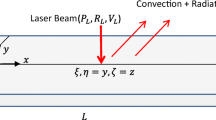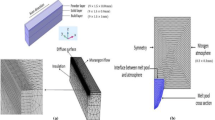Abstract
Laser powder-bed fusion (LPBF) is one of the mainstream additive manufacturing (AM) processes, which has dominated the metal AM manufacturing market. LPBF has the capability to manufacture complex parts, which pose a manufacturing challenge by conventional methods. In this paper, an efficient numerical-experimental approach has been introduced to calibrate the parameters of a proposed three-dimensional (3D) conical Gaussian moving laser heat source model. For this purpose, several Hastelloy X single tracks are printed with various process parameters. The melt pool depth and width were measured experimentally, and results were used to calibrate and validate the heat source model. An empirical relationship between heat source parameters and laser energy density was also proposed. In addition, temperature gradients and cooling rates around the melt pool were extracted from the numerical model to be used towards microstructure prediction. Estimated microstructure cell spacing, calculated based on predicted cooling rate during solidification, was in good agreement with experimental measurements, indicating the validity of the heat source model.


















Similar content being viewed by others
Abbreviations
- k e :
-
Effective thermal conductivity of powder
- k g :
-
Thermal conductivity of the continuous gas phase
- k s :
-
Thermal conductivity of skeletal solid
- φ :
-
The porosity of powder bed
- k R :
-
Thermal conductivity part of the powder bed owing to radiation
- ∅:
-
The flattened surface fraction of particle in contact with another particle
- B :
-
Deformation parameter of the particle
- k contact :
-
Contact conductivity between two particles according to the value of ∅
- C p :
-
Specific heat
- L :
-
Latent heat
- ρ :
-
Density
- k :
-
Thermal conductivity
- Q :
-
Internal heat generation
- h c :
-
Heat transfer coefficient
- ε :
-
Emissivity coefficient
- σ sb :
-
Stefan-Boltzmann coefficient
- q c :
-
Convective heat dissipation
- q r :
-
Radiative heat dissipation
- I :
-
Heat intensity distribution
- q 0 :
-
The maximum value of heat intensity
- r 0 :
-
The top radius of heat source
- r d :
-
The bottom radius of heat source
- z e :
-
Z coordinates of the top surface of heat source
- z i :
-
Z coordinates of the bottom surface of heat source
- H :
-
Height of heat source
- α :
-
Absorption coefficient
- P :
-
Laser power
- V :
-
Scanning speed
- \( \dot{T} \) :
-
Cooling rate
- λ 1 :
-
Primary spacing
References
Stavropoulos P, Foteinopoulos P (2018) Modelling of additive manufacturing processes: a review and classi fi cation. Manuf Rev 2
Fayazfar H et al (2018) A critical review of powder-based additive manufacturing of ferrous alloys: process parameters, microstructure and mechanical properties. Mater Des 144:98–128
Chiumenti M et al (2017) Numerical modelling and experimental validation in selective laser melting. Addit Manuf 18:171–185
Luo C, Qiu J, Yan Y, Yang J, Uher C, Tang X (2018) Finite element analysis of temperature and stress fields during the selective laser melting process of thermoelectric SnTe. J Mater Process Technol 261(June):74–85
Peng H et al (2018) Fast prediction of thermal distortion in metal powder bed fusion additive manufacturing: part 2, a quasi-static thermo-mechanical model. Addit Manuf 22(2010):869–882
Kundakc E et al (2018) Thermal and molten pool model in selective laser melting process of Inconel 625. Int J Adv Manuf Technol
Liu S, Zhu H, Peng G, Yin J, Zeng X (2018) Microstructure prediction of selective laser melting AlSi10Mg using finite element analysis. Mater Des 142:319–328
Antony K, Arivazhagan N, Senthilkumaran K (2014) Numerical and experimental investigations on laser melting of stainless steel 316L metal powders. J Manuf Process 16(3):345–355
H. Ali, H. Ghadbeigi, and K. Mumtaz, “Residual stress development in selective laser-melted Ti6Al4V: a parametric thermal modelling approach” 2018
Du Y, You X, Qiao F, Guo L, Liu Z (2019) A model for predicting the temperature field during selective laser melting. Results Phys 12(November 2018):52–60
Zhang Z et al (2019) 3-dimensional heat transfer modeling for laser powder-bed fusion additive manufacturing with volumetric heat sources based on varied thermal conductivity and absorptivity. Opt Laser Technol 109:297–312
Wu CS, Wang HG, Zhang YM (2006) A new heat source model for keyhole plasma arc welding in FEM analysis of the temperature profile. Weld J 85(12):284
Bonakdar A, Molavi-Zarandi M, Chamanfar A, Jahazi M, Firoozrai A, Morin E (2017) Finite element modeling of the electron beam welding of Inconel-713LC gas turbine blades. J Manuf Process 26:339–354
EOS GmbH - Electro Optical Systems (2015) Material data sheet EOS NickelAlloy HX Material data sheet Technical data
Esmaeilizadeh R, Ali U, Keshavarzkermani A, Mahmoodkhani Y, Marzbanrad E, Toyserkani E (2019) On the effect of spatter particles distribution on the quality of Hastelloy X parts made by laser powder-bed fusion additive manufacturing. J Manuf Process 37(November 2018):11–20
Ali U et al (2018) On the measurement of relative powder-bed compaction density in powder-bed additive manufacturing processes. J Mater Des
Sih SS, Barlow JW (2004) The prediction of the emissivity and thermal conductivity of powder beds. Part Sci Technol 22(4):427–440
Promoppatum P, Yao S, Pistorius PC, Rollett AD (2017) A comprehensive comparison of the analytical and numerical prediction of the thermal history and solidification microstructure of Inconel 718 products made by laser powder-bed fusion. Engineering 3(5):685–694
Huang W, Zhang Y (2019) Finite element simulation of thermal behavior in single-track multiple-layers thin wall without-support during selective laser melting. J Manuf Process 42(April):139–148
Luo C, Qiu J, Yan Y, Yang J, Uher C, Tang X (2018) Finite element analysis of temperature and stress fields during the selective laser melting process of thermoelectric SnTe. J Mater Process Technol 261(February):74–85
Gouge M, Michaleris P (2017) Thermo-mechanical modeling of additive manufacturing, 1st edn. Elsevier Inc.
Kreith F, Manglik RM, Bohn MS (2012) Principles of heat transfer. Cengage Learning
King WE et al (2014) Observation of keyhole-mode laser melting in laser powder-bed fusion additive manufacturing. J Mater Process Technol 214(12):2915–2925
Trapp J, Rubenchik AM, Guss G, Matthews MJ (2017) In situ absorptivity measurements of metallic powders during laser powder-bed fusion additive manufacturing. Appl Mater Today 9:341–349
Keshavarzkermani A et al (2019) An investigation into the effect of process parameters on melt pool geometry, cell spacing, and grain refinement during laser powder bed fusion. Opt Laser Technol 116(January):83–91
Acharya R, Sharon JA, Staroselsky A (2017) Prediction of microstructure in laser powder bed fusion process. Acta Mater 124:360–371
Darvish K, Chen ZW, Phan MAL, Pasang T (2018) Materials characterization selective laser melting of Co-29Cr-6Mo alloy with laser power 180–360 W: cellular growth , intercellular spacing and the related thermal condition. Mater Charact 135(November 2017):183–191
Kurz W, Trivedi R (1994) Rapid solidification processing and microstructure formation. 17:46–51
S. Kou, Welding metallurgy. 2002
Harrison NJ, Todd I, Mumtaz K (2015) Reduction of micro-cracking in nickel superalloys processed by selective laser melting: a fundamental alloy design approach. Acta Mater 94:59–68
Acknowledgments
The authors would like to appreciate the Federal Economic Development Agency for Southern Ontario (FedDev Ontario), Natural Sciences and Engineering Research Council of Canada (NSERC), and Siemens Canada Limited, for supporting financially. In addition, special thanks to Jerry Ratthapakdee and Karl Rautenberg for assisting in preparing the LPBF setup and printing the samples, National Research Council Canada (NRC) and Adhitan Rani Kasinathan for their contributions to the LPBF modeling.
Author information
Authors and Affiliations
Corresponding author
Additional information
Publisher’s note
Springer Nature remains neutral with regard to jurisdictional claims in published maps and institutional affiliations.
Rights and permissions
About this article
Cite this article
Shahabad, S.I., Zhang, Z., Keshavarzkermani, A. et al. Heat source model calibration for thermal analysis of laser powder-bed fusion. Int J Adv Manuf Technol 106, 3367–3379 (2020). https://doi.org/10.1007/s00170-019-04908-3
Received:
Accepted:
Published:
Issue Date:
DOI: https://doi.org/10.1007/s00170-019-04908-3




